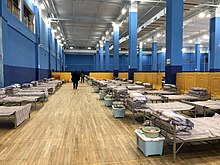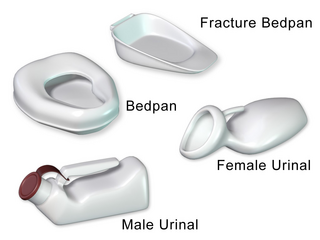
In hospitals and other medical facilities, an isolation ward is a separate ward used to isolate patients with infectious diseases. Several wards for individual patients are usually placed together in an isolation unit.[ citation needed ]

In hospitals and other medical facilities, an isolation ward is a separate ward used to isolate patients with infectious diseases. Several wards for individual patients are usually placed together in an isolation unit.[ citation needed ]
In an isolation unit, several measures must be implemented in order to reduce the spread of infection. The units are generally placed away from the main hospital, and staff often only work in that unit. In some hospitals, the unit is placed in a separate building. Ventilation is important to reduce the transmission of airborne spores, and the most severely affected patients are placed in separate wards. [1] [2] However, in some circumstances, especially in areas experiencing a major epidemic, makeshift isolation wards can be constructed. [3]
Isolation wards are used to isolate patients who pose a risk of passing a potentially harmful infection on to others. Such infections can range in severity widely, from diseases such as influenza to ebola, although more precautions are generally taken with diseases of a higher mortality rate. Outside major hospitals, isolation wards can be set up to control infection in crowded places, or those lacking substantial medical facilities. [3] Many major passenger ships contain separate wards which can be converted for use in isolating patients. [4] [5]
Body substance isolation is a practice of isolating all body substances of individuals undergoing medical treatment, particularly emergency medical treatment of those who might be infected with illnesses such as HIV, or hepatitis so as to reduce as much as possible the chances of transmitting these illnesses. BSI is similar in nature to universal precautions, but goes further in isolating workers from pathogens, including substances now known to carry HIV.

Psychiatric hospitals, also known as mental health hospitals or behavioral health hospitals, are hospitals or wards specializing in the treatment of severe mental disorders, including schizophrenia, bipolar disorder, eating disorders, dissociative identity disorder, major depressive disorder, and others.

An emergency department (ED), also known as an accident and emergency department (A&E), emergency room (ER), emergency ward (EW) or casualty department, is a medical treatment facility specializing in emergency medicine, the acute care of patients who present without prior appointment; either by their own means or by that of an ambulance. The emergency department is usually found in a hospital or other primary care center.

Methicillin-resistant Staphylococcus aureus (MRSA) is a group of gram-positive bacteria that are genetically distinct from other strains of Staphylococcus aureus. MRSA is responsible for several difficult-to-treat infections in humans. It caused more than 100,000 deaths worldwide attributable to antimicrobial resistance in 2019.

Klebsiella pneumoniae is a Gram-negative, non-motile, encapsulated, lactose-fermenting, facultative anaerobic, rod-shaped bacterium. It appears as a mucoid lactose fermenter on MacConkey agar.

A hospital-acquired infection, also known as a nosocomial infection, is an infection that is acquired in a hospital or other healthcare facility. To emphasize both hospital and nonhospital settings, it is sometimes instead called a healthcare-associated infection. Such an infection can be acquired in hospital, nursing home, rehabilitation facility, outpatient clinic, diagnostic laboratory or other clinical settings. A number of dynamic processes can bring contamination into operating rooms and other areas within nosocomial settings. Infection is spread to the susceptible patient in the clinical setting by various means. Healthcare staff also spread infection, in addition to contaminated equipment, bed linens, or air droplets. The infection can originate from the outside environment, another infected patient, staff that may be infected, or in some cases, the source of the infection cannot be determined. In some cases the microorganism originates from the patient's own skin microbiota, becoming opportunistic after surgery or other procedures that compromise the protective skin barrier. Though the patient may have contracted the infection from their own skin, the infection is still considered nosocomial since it develops in the health care setting. Nosocomial infection tends to lack evidence that it was present when the patient entered the healthcare setting, thus meaning it was acquired post-admission.

In urology, a Foley catheter is a brand name for one of many brands of urinary catheters (UC). Foleys and their namesakes are indwelling UC, often referred to as an IDCs or the alternative type being an in/out catheters. The foley UC was named after Frederic Foley, who produced the original design in 1929. The UC is a flexible tube if it is indwelling and stays put, or rigid if it is in/out, that a clinician, or the client themselves, often in the case of in/out UC, passes it through the urethra and into the bladder to drain urine.

A bedpan or bed pan is a device used as a receptacle for the urine and/or feces of a person who is confined to a bed and therefore not able to use a toilet or chamber pot.
Infection prevention and control is the discipline concerned with preventing healthcare-associated infections; a practical rather than academic sub-discipline of epidemiology. In Northern Europe, infection prevention and control is expanded from healthcare into a component in public health, known as "infection protection". It is an essential part of the infrastructure of health care. Infection control and hospital epidemiology are akin to public health practice, practiced within the confines of a particular health-care delivery system rather than directed at society as a whole.
Enterococcus faecium is a Gram-positive, gamma-hemolytic or non-hemolytic bacterium in the genus Enterococcus. It can be commensal in the gastrointestinal tract of humans and animals, but it may also be pathogenic, causing diseases such as neonatal meningitis or endocarditis.

In health care facilities, isolation represents one of several measures that can be taken to implement in infection control: the prevention of communicable diseases from being transmitted from a patient to other patients, health care workers, and visitors, or from outsiders to a particular patient. Various forms of isolation exist, in some of which contact procedures are modified, and others in which the patient is kept away from all other people. In a system devised, and periodically revised, by the U.S. Centers for Disease Control and Prevention (CDC), various levels of patient isolation comprise application of one or more formally described "precaution".

A hospital is a healthcare institution providing patient treatment with specialized health science and auxiliary healthcare staff and medical equipment. The best-known type of hospital is the general hospital, which typically has an emergency department to treat urgent health problems ranging from fire and accident victims to a sudden illness. A district hospital typically is the major health care facility in its region, with many beds for intensive care and additional beds for patients who need long-term care. Specialized hospitals include trauma centers, rehabilitation hospitals, children's hospitals, seniors' (geriatric) hospitals, and hospitals for dealing with specific medical needs such as psychiatric treatment and certain disease categories. Specialized hospitals can help reduce health care costs compared to general hospitals. Hospitals are classified as general, specialty, or government depending on the sources of income received.

Negative room pressure is an isolation technique used in hospitals and medical centers to prevent cross-contamination from room to room. It includes a ventilation that generates negative pressure to allow air to flow into the isolation room but not escape from the room, as air will naturally flow from areas with higher pressure to areas with lower pressure, thereby preventing contaminated air from escaping the room. This technique is used to isolate patients with airborne contagious diseases such as: influenza (flu), measles, chickenpox, tuberculosis (TB), severe acute respiratory syndrome (SARS-CoV), Middle East respiratory syndrome (MERS-CoV), and coronavirus disease 2019 (COVID-19).
Transmission-based precautions are infection-control precautions in health care, in addition to the so-called "standard precautions". They are the latest routine infection prevention and control practices applied for patients who are known or suspected to be infected or colonized with infectious agents, including certain epidemiologically important pathogens, which require additional control measures to effectively prevent transmission. Universal precautions are also important to address as far as transmission-based precautions. Universal precautions is the practice of treating all bodily fluids as if it is infected with HIV, HBV, or other blood borne pathogens.
Carbapenem-resistant Enterobacteriaceae (CRE) or carbapenemase-producing Enterobacteriaceae (CPE) are Gram-negative bacteria that are resistant to the carbapenem class of antibiotics, considered the drugs of last resort for such infections. They are resistant because they produce an enzyme called a carbapenemase that disables the drug molecule. The resistance can vary from moderate to severe. Enterobacteriaceae are common commensals and infectious agents. Experts fear CRE as the new "superbug". The bacteria can kill up to half of patients who get bloodstream infections. Tom Frieden, former head of the Centers for Disease Control and Prevention has referred to CRE as "nightmare bacteria". Examples of enzymes found in certain types of CRE are KPC and NDM. KPC and NDM are enzymes that break down carbapenems and make them ineffective. Both of these enzymes, as well as the enzyme VIM have also been reported in Pseudomonas.
Barrier nursing is a term for a set of stringent infection control techniques used in nursing. The aim of barrier nursing is to protect medical staff against infection by patients and also protect patients with highly [infectious disease]from spreading their pathogens to other non-infected people.
Catherine-de-Barnes Isolation Hospital was a specialist isolation hospital for infection control in Catherine-de-Barnes, a village within the Metropolitan Borough of Solihull in the English county of West Midlands.
Invasive candidiasis is an infection (candidiasis) that can be caused by various species of Candida yeast. Unlike Candida infections of the mouth and throat or vagina, invasive candidiasis is a serious, progressive, and potentially fatal infection that can affect the blood (fungemia), heart, brain, eyes, bones, and other parts of the body.

A fever hospital or isolation hospital is a hospital for infectious diseases such as Scarlet fever, Tuberculosis, Lassa fever and Smallpox. Their purpose is to treat affected people while isolating them from the general population. Early examples included the Liverpool Fever Hospital (1801) and the London Fever Hospital (1802). Other examples occurred elsewhere in the British Isles and India.

An isolation pod is a capsule which is used to provide medical isolation for a patient. Examples include the Norwegian EpiShuttle and the USAF's Transport Isolation System (TIS) or Portable Bio-Containment Module (PBCM), which are used to provide isolation when transporting patients by air.